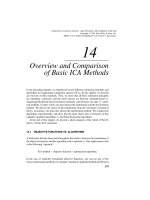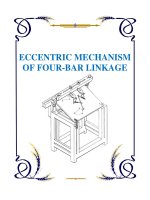Atlas of Our Changing Environment pptx
Bạn đang xem bản rút gọn của tài liệu. Xem và tải ngay bản đầy đủ của tài liệu tại đây (40.94 MB, 168 trang )
i
KENYA
Atlas of Our Changing Environment
D
E
V
E
L
O
P
M
E
N
T
M
A
P
P
I
N
G
F
O
R
S
U
S
T
A
I
N
A
B
L
E
RCMRD
Government
of Norway
ii
UNEP promotes
environmentally sound practices
globally and in its own activities. This publication
is printed on 100 per cent chlorine free paper from
sustainably managed forests. Our distribution policy aims
to reduce UNEP’s carbon footprint.
© 2009, United Nations Environment Programme
ISBN: 978-92-807-2995-5
Job Number: DEW/1129/NA
This publication may be reproduced in whole or in part and in any form for educational or non-profi t purposes
without special permission from the copyright holder, provided acknowledgement of the source is made. UNEP and
the authors would appreciate receiving a copy of any publication that uses this report as a source.
No use of this publication may be made for resale or for any other commercial purpose whatsoever without prior
permission in writing from the United Nations Environment Programme.
United Nations Environment Programme
PO Box 30552, Nairobi 00100, Kenya
Tel: +254 20 7621234
Fax: +254 20 7623943/44
United Nations Environment Programme
Global Resource Information Database — Sioux Falls
47914 252nd Street, USGS, Earth Resources Observation and Science (EROS) Center
Sioux Falls, SD 57198-0001 USA
Tel: 1-605-594-6117
Fax: 1-605-594-6119
www.na.unep.net
For bibliographic and reference purposes this publication should be referred to as:
UNEP (2009), “Kenya: Atlas of Our Changing Environment.”
Division of Early Warning and Assessment (DEWA)
United Nations Environment Programme (UNEP)
P.O. Box 30552
Nairobi 00100, Kenya
This book is available from Earthprint.com,
Printed by ProgressPress Co. Ltd., Malta
Distribution by SMI London
The following organisations collaborated on this Atlas:
• United Nations Environment Programme (UNEP)
• Government of Kenya (GoK)
• Regional Centre for Mapping of Resources for Development (RCMRD)
• United States Geological Survey (USGS)
The funding support for this Atlas was provided by the Government of Norway. United States Geological Survey
(USGS) Earth Resources Observation and Science (EROS) Center, the host of UNEP/GRID - Sioux Falls, provided
all the necessary support needed for visiting scientists and production of this Atlas.
Special thanks are extended to the United States Department of State, the National Aeronautics and Space
Administration (NASA), the US National Geospatial-Intelligence Agency (NGA), Planet Action Initiative, ©CNES
2008, Distribution Spot Image S.A., France, and Google Earth for providing access to satellite data. Appreciation is
also extended to Environmental Systems Research Institute (ESRI) for software support.
DISCLAIMER
The views expressed in this publication are not necessarily those of the agencies cooperating in this project. The
designations employed and the presentations do not imply the expression of any opinion whatsoever on the part of
UNEP or cooperating agencies concerning the legal status of any country, territory, city, or area of its authorities, or
the delineation of its frontiers or boundaries.
Mention of a commercial company or product in this report does not imply endorsement by the United Nations
Environment Programme. The use of information from this publication concerning proprietary products for
publicity or advertising is not permitted. Trademark names and symbols are used in an editorial fashion with no
intention of infringement on trademark or copyright laws.
We regret any errors or omissions that may have been unwittingly made.
iii
Preface iv
Foreword v
Chapter 1: Environment and Vision 2030
Kenya’s Vision 2030 1
Kenya’s Forests and the Economic and Social Pillars 4
Five water towers: Kenya’s water catchments—a fl agship project for 2012 7
The Mau Forest Complex 8
Mount Kenya 14
The Aberdare Range 18
Mount Elgon 20
The Cherangani Hills 22
Tourism 24
Energy 32
Environmental Disasters and Challenges to Vision 2030 37
Chapter 2: Millennium Development Goals
The Millennium Declaration 41
Environmental links to the MDGs 43
Kenya’s progress towards achieving the Millennium Development Goals 44
Kenya’s progress towards MDG 7: Ensure Environmental Sustainability 45
The Environment and Poverty 55
Climate Change and the MDGs 56
Climate Change and Human Health 57
Climate Change and Food Security 59
Climate Change and Floods and Droughts 60
Climate Change and Land Degradation 61
Climate Change and Pests 63
Chapter 3: Transboundary Issues
Transboundary Environmental Issues 67
Transboundary Protected Ecosystems 69
Transboundary Water Resources 71
Lake Victoria Basin 71
Mara River Basin 76
The Juba-Shebelle Basin 76
The Natron Basin 77
Lake Turkana Basin 78
Transboundary Movement of People 82
Transboundary Movement of Pests and Diseases 86
Pest Infestations 86
Infectious Diseases 86
Chapter 4: Environmental Hotspots
Land Use and Land Use Change 90
Water 106
Forests 114
Land Degradation 120
Biodiversity 132
Chapter 5: Nairobi's Environment
Nairobi, A Burgeoning City 145
Major Environmental Issues 149
Planning for the Future 156
Acronyms 158
Editorial and Production Team 159
Index 160
Table of Contents
iv
Preface
Kenyan’s livelihoods are closely linked to their access to natural resources. As our population increases
and environmental quality continues to decline, there is an increased risk of social and economic
destabilization, which will have signifi cant impacts on overall national security. Rural people are among
the most vulnerable and insecure in terms of poverty, health, food security, economic losses, and confl icts
resulting from competitive access to natural resources, among other factors.
The country is already witnessing an increased frequency of resource-use confl icts in the north-eastern
and north-western regions. There are tensions among downstream and upstream communities in some river
systems, for example. Extreme climatic events such as fl oods and drought are affecting an increasingly
larger proportion of the rural population and introducing shocks into Kenya’s macro-economy. The overall
success of Vision 2030 therefore hinges on how well we manage the environment over the next 25 years.
Now is the time for strategic thinking and planning. To do this in a rapidly evolving situation
demands the provision of credible and timely environmental information. This information should be
easily understood and used by every Kenyan who makes daily decisions related to managing his or her
environment. The Ministry of Environment and Mineral Resources is thus very pleased to launch Kenya:
Atlas of Our Changing Environment, which gives every Kenyan and all our development partners a vivid
picture of what is happening to our ecosystems, which are the basis of our very survival.
The government of Kenya is extremely indebted to UNEP for its support in preparing this Atlas. Indeed,
it is honoured to host this very important global institution at a critical time when decisions about how
we manage the global environment can determine humanity’s continued existence. As a nation, we are
determined to take full advantage of UNEP’s presence in Kenya to fortify our capacity in environmental
management and take full charge of our destiny.
I would like to congratulate all those experts, national and international, as well as development partners
whose dedication and contribution has made this stunning publication possible in record time!
The value of the information in this publication is priceless, but can only be demonstrated through the
actions we will take as individuals and as a nation to restore the integrity of our natural resources. It is my
sincere hope that what we read and see in this report will inspire all of us into action. “Seeing is believing”.
I wish you a good reading.
Honorable John Michuki, EGH, MP
Minister for Environment and
Mineral Resources
MINISTRY OF ENVIRONMENT AND MINERAL RESOURCES
v
Foreword
Economic development in Kenya is largely underpinned by the quality and integrity of the country’s rich
natural resource base, which has also helped it maintain a strategic position in the region. The country is
renowned for its nature-based tourism and has some of the world’s best and most-visited national parks.
The climate supports a vibrant agricultural sector and its forests and savannas are rich in biodiversity and
impressive wildlife numbers, which support the profi table tourism sector. Environmental change in the form
of degradation is threatening the natural resource base, however, and therefore affecting Kenyan livelihoods.
Kenya: Atlas of Our Changing Environment, produced at the request of the Kenya Government, provides
visual and compelling evidence of the rapid changes taking place in the country's critical ecosystems due
to pressures from human activities. The side-by-side display of historical and current remote-sensing
images highlight forest degradation, wetland drainage, and shrinking lakes to the impacts of refugees on
fragile ecosystems and signs of coastal degradation. The Atlas provides a good evidence base for strategic
intervention by the government and communities.
The Atlas is thus an important resource for setting the context and establishing a baseline for the
realization of Kenya's Vision 2030. Among the ways it does this are the following:
• Discussing the contribution of key natural resources to the achievement of Vision 2030 by describing
the interlinkages between major socio-economic activities in the country to the environment. Examples
include the link between energy supplies, which underpin industrial development including tourism,
and forest ecosystems that collect and store water in Kenya’s fi ve “water towers,” and the link between
agricultural productivity and forests, which regulate the micro-climates that make farming possible.
• By focusing on Kenya's progress towards achieving Millennium Development Goal 7, which aims to
ensure environmental sustainability, it provides an opportunity for the country to re-examine practical
strategies for making rapid progress towards achieving this goal. It can do this by addressing salient
environmental challenges explored in the Atlas, such as protecting water sources from point-source
pollution and conserving water catchments, among others.
The Kenya government’s request for support to produce this Atlas, which came immediately after
the launch of Africa: Atlas of Our Changing Environment, demonstrates the government's desire to bring
scientifi c evidence of environmental change derived from Earth observation science to the fore of Kenya’s
natural resources management to help make decisions that will stand the test of time. This national Atlas for
Kenya is the latest in a series of UNEP Atlases of environmental change, following the aforementioned Africa
atlas and the highly successful global atlas, One Planet Many People.
UNEP would like to thank the government of Kenya for taking the initiative, the government of Norway
for its generous fi nancial contribution, our United Nations partners in Kenya, as well as the United States
government whose support through agencies made the satellite data analysis possible.
Achim Steiner
United Nations Under Secretary-General,
and Executive Director, United Nations
Environment Programme
UNEP
vi
vi
Kenya Atlas.indd viKenya Atlas.indd vi 1/13/09 12:41:36 PM1/13/09 12:41:36 PM
vii
The
Sun
The Sun drives most of the processes that make life on Earth
possible. In fact, the Sun helped create our planet. The Earth is
composed of matter collected around the Sun over billions of years
due to the Sun's gravity. Even from some 149 million kilometres
away, the sun warms the Earth's surface by 250ºC. It drives our
weather, ocean currents, and photosynthesis. Its no wonder many
ancient societies revered it.
The Sun's e ect on Earth varies with location. For example, at
the poles, the Sun's rays hit the Earth at an indirect angle. The Sun
disappears for weeks during the winter but shines 24 hours a day
during the summer. Kenya, on the other hand, straddles the equator,
where the sun's rays strike at an angle of nearly 90º. It drives the
rainy season and makes plant life possible, including Kenya's forests
and crops.
/>vii
viii
Arshia Chander, SGT/UNEP Sioux Falls
viii
1
"Kenya aims to be a nation living in a clean,
secure, and sustainable environment by 2030"
-Kenya Vision 2030
(GoK 2007)
A
s a newly industrializing country, Kenya faces the challenge of improving its economic
performance and the lives of its citizens without undermining the environment upon which
so much of its national earnings and individual people’s livelihoods depend. This chapter
introduces the theme of environmental change in Kenya through the lens of the country’s long-term national
development plan known as Kenya Vision 2030. It looks at a select number of salient and emerging issues
that need to be considered to achieve the Vision’s goals and targets, including how to protect the country’s
water sources that feed hydropower, support wildlife and tourism destinations, irrigate both export and small
holder farms, and nurture grazing areas. It also highlights the importance of planning for weather-related
disasters to enable development goals to be achieved.
Kenya’s Vision 2030
Kenya Vision 2030 is the country’s new development blueprint for the period 2008 to 2030. It aims to make
Kenya a “middle income country providing high quality life for all its citizens by the year 2030”. The fi rst
phase of the Kenya Vision 2030 covers the period 2008 to 2012 during which a number of “fl agship” projects
will be implemented. Vision 2030 is based on three pillars: the economic pillar, the social pillar, and the
political pillar. In one way or another, these pillars are all interrelated and the fi bre that binds them together
Chapter 1: Environment and Vision 2030
Sunrise Over Maasai Mara
The 1 510 km
2
Maasai Mara Game
Reserve is one of the greatest regions
of migrating wildlife in the world. It
is shared by Kenya and the United
Republic of Tanzania. Every year,
herds of wildebeest, zebras and
other herbivores migrate between
Maasai Mara and Serengeti National
Park (Tanzania) during the Great
Migration (July - October)
Figure 1: Thematic overview of the Kenya Vision 2030 (Source: GoK 2007)
Plans and
implementation
Vi-
sion
Strategy
Economic
To maintain a
sustained
economic growth of
10% p.a. over the
next 25 years
Social
A just and cohesive
society enjoying
equitable social
development in a
clean and secure
environment
Political
An issue-based,
people-centered,
result-oriented, and
accountable
democratic political
system
Overarching vision
A globally competitive and
prosperous nation with a high
quality of life by 2030
2
is the natural environment, with its inherent supply of renewable and non-
renewable goods and services.
Development objectives and the need to protect and maintain the
natural environment must go hand in hand. This is because environmental
sustainability, including the conservation of biodiversity, underpins human
well-being (UN 2005). Our natural environment not only provides us with
the basic goods needed for sustenance, such as water, food, and fi bre, but it
also purifi es the air and water, produces healthy soils, cycles nutrients, and
regulates the climate. These ecosystem services provided by the environment
0
10 000
20 000
30 000
40 000
50 000
60 000
70 000
80 000
90 000
1950 1960 1970 1980 1990 2000 2010 2020 2030 2040 2050
Ur ba n
Rural
Total
Population (thousands)
Figure 2: Kenya’s projected rural and urban population, 1950-2050
(Source: UNPD 2008)
7
0
0
0
0
8
0
0
0
0
9
0
0
0
0
1950 1960
9.6 Ha
Per Person
7.2 Ha
Per Person
5.2 Ha
Per Person
3
1970 1980 1990 2000 2005 2015 2050
3.6 Ha
Per Person
2.5 Ha
Per Person
1.9 Ha
Per Person
1.3 Ha
Per Person
1.7 Ha
Per Person
0.3 Ha
Per Person
are important for developing and maintaining human
health, creating national wealth, and reducing poverty
(UN 2005).
Population Challenges for Vision 2030
Currently, Kenya’s population is nearly 38 million, having grown
from just eight million in 1960. With a yearly growth rate of 2.8 per cent
it is projected to reach 51 million by 2025 (Thaxton 2007). Vision 2030
should plan for and ensure an equivalent economic growth to accommodate its
growing population. The proportion of Kenyans living in urban areas increased from
7.4 per cent in 1960 to 21.3 per cent in 2007. By 2030, it is projected that 33 per cent of
Kenyans will live in urban areas (UNPD 2008); to achieve Vision 2030, this fact must also
be considered. Increasing the number of people living in the same area adds pressure on land and
its resources. In a hypothetical situation in which land is shared equally among the population base,
as time passes and population increases, each individual’s share of land would decrease, as illustrated in
Figure 3.
Environmental Goals for 2012
The Government of Kenya understands and appreciates the important function that the environment plays
in underpinning development. It is cognizant that achieving Vision 2030 depends on maintaining the
natural systems that support agriculture, energy supplies, livelihood strategies, and tourism. Table 1 on the
following page illustrates how the environment cuts across Vision 2030’s pillars.
To support the social pillar, Kenya aims to provide its citizens with a clean, secure, and sustainable
environment by the year 2030. To achieve this, the nation has set goals such as increasing forest cover
from less than three per cent of its land base at present to four per cent by 2012 and to lessen by half all
environment related diseases by the same time (GoK 2007).
Among the strategies for achieving these goals are the following: promoting environmental conservation
to help achieve the Millennium Development Goals (MDGs); improving pollution and waste management
through the design and application of economic incentives; and commissioning public-private partnerships
(PPPs) for improved effi ciency in water and sanitation delivery. Kenya will enhance disaster preparedness
in all disaster-prone areas and improve the capacity for adaptation to the impacts of global climate change.
In addition, the country will harmonize environment-related laws for better environmental planning and
governance (GoK 2007).
Figure 3: Kenya’s shrinking land base
(Source: UNPD 2008)
The amount of land available to each person
in Kenya has decreased from 9.6 ha in 1950
to 1.7 ha in 2005. It is projected that available
land will further decline to 0.3 ha per person
by 2050
0
2
4
6
8
10
12
1950 1960 1970 1980 1990 2000 2005 2015 2050
Hectares Per Person
Christian Lambrechts/UNEP
Smoke rises from farmers clearing small patches of land
4
Kenya’s Forests and the Economic and Social Pillars
Forests cover only about three per cent of Kenya’s land area, yet they provide crucial direct and indirect
goods and services to its people and make a signifi cant contribution to the national economy. About 70
per cent of Kenya’s domestic energy comes from wood, for example, and out of the 20 million m
3
of
fuelwood consumed annually, 95 per cent is collected from forests and rangelands (MENR 1994). In
addition to providing a variety of wood and non-timber products, Kenya’s forests provide the following
ecosystem services: they trap and store rain water; regulate river fl ows and prevent fl ooding; help recharge
ground-water tables; improve soil fertility; reduce soil erosion and sediment loads in river water; help
regulate local climate conditions; and act as carbon reservoirs and sinks.
Many forests serve as essential wildlife habitats, and are traditionally important for cultural ceremonies
and as sacred sites to local communities. It is estimated that 530 000 forest-adjacent households (which
amount to 2.9 million people living within fi ve kilometres from forests) derive direct benefi ts from
indigenous closed-canopy forests. This amounts to about eight per cent of Kenya’s population. Estimates
indicate that in some areas, the forestry sector contributes about 70 per cent of the cash income of forest
adjacent households (Wass 1995).
Forests play a critical role as water catchments. In addition to retaining and fi ltering water for
human uses, forests contribute to the availability of water for hydro power, which supplies Kenya
with close to 60 per cent of its electricity generation. Forests also help to reduce siltation in
hydroelectric empoundments.
Figure 4: Land use area, 2005
(Source: KFS 2006)
Kenya’s land cover is dominated by
woodlands, grasslands, and farmlands
Table 1: The crosscutting nature of the environment that underlies Vision 2030’s pillars
Pillars Sectors 2012 Targets Environmental Challenges
and Bene ts
Economic Tourism • Increase number of visitors • Develop tourism infrastructure
from 1.8 million per year to (accommodation, transport) with
3 million light environmental footprint so as to
preserve the natural assets
Agriculture • Add value to crop, livestock, • Plan processing plants to avoid
and sh products by environmental impacts
processing domestically • Ensure lands, weather conditions
• Cultivate idle land and open and water availability are suitable for
up new agricultural lands cultivation; plan ahead to adapt to
climate change in these areas
• Avoid encroachment on sensitive
ecosystems and marginal lands
Social Health, water, • Lessen by half all • Be proactive in preventing disease
and sanitation environment related diseases (instead of end-of-pipe solutions) by
• Improve access to safe water protecting and improving access to
and sanitation water sources and providing adequate
• Increase irrigation and drainage sanitation facilities
levels to promote agricultural • Conserve water sources
productivity • Introduce innovative water harvesting
and drainage schemes
Environment • Increase forest cover from • Increase forest cover, which will help
less than three per cent to sustain water catchments for
four per cent hydropower, agriculture, municipalities,
wildlife and tourism, etc
• prevent erosion
• increase biodiversity
• sequester carbon
• provide timber to local people,
among other environmental,
social, and economic bene ts
Housing • Increase annual housing • Ensure urban plans are
and urbanization unit production from environmentally sustainable in terms
35 000 to 200 000 of building materials, location,
transport options, etc.
Equity and • Reduce the number of • Ensure the equitable access of all
poverty elimination people living in poverty people to the environmental
to a tiny proportion of the resources they need to sustain their
total population livelihoods, and that these resources
are managed sustainably
5
UNITED REPUBLIC
OF TANZANIA
ETHIOPIA
UGANDA
SUDAN
SOMALIA
Lake
Victoria
Lake
Turkana
INDIAN
OCEAN
0100200
Kilometres
Town
Capital City
Major Town
500
1 000
1 500
2 000
!
! (
! \
! (
Lodwar
Mombasa
NAIROBI
Nakuru
Kisumu
!
Garissa
Lake
Government
Protected Forest
Elevation
(Metres)
N
Figure 5: Forests are concentrated in Kenya’s moist highlands where human populations and agricultural production are also concentrated. In
the extensive semi-arid regions, forests are mainly found on isolated hills and in discontinuous narrow bands along riverbeds. Kenya has 258
forest reserves.
Protected Forests
WDPA 2007
5
6
Figure 6: The ve water towers of Kenya
Five Water Towers
6
UNITED REPUBLIC
OF TANZANIA
ETHIOPIA
UGANDA
SUDAN
SOMALIA
Lake
Victoria
Lake
Turkana
INDIAN
OCEAN
Elevation
(Metres)
0100200
Kilometres
Lake
“Water Towers”
River
Turkwel
Ewaso Nyiro
Tana
Athi
Sondu
Yala
Nzoia
Kerio
Mara
Ewaso Nyiro
!
! (
!
! \
! (
Lodwar
Mombasa
NAIROBI
Nakuru
Kisumu
!
Garissa
1
2
3
4
5
1. Mt. Elgon
2. Cherangani Hills
3. Mau Complex
4. Aberdare Range
5. Mt. Kenya
500
1 000
1 500
2 000
N
DRSRS and KFWG 2006
7
Five water towers: Kenya’s water catchments—a agship project for 2012
The fi ve “water towers” of Kenya — Mount Kenya, the Aberdare Range, the Mau Forest Complex, Mount
Elgon, and the Cherangani Hills — are montane forests and the fi ve largest forest blocks in the country. They
form the upper catchments of all the main rivers in Kenya (except the Tsavo River originating from Mt.
Kilimanjaro). The “water towers” are sources of water for irrigation, agriculture, industrial processes, as well
as to all installed hydro-power plants, which produce about 60 per cent of Kenya’s electricity output.
These montane forests are also surrounded by the most densely populated areas of Kenya, because
they provide enough water for intensive agriculture and urban settlements (DRSRS and KFWG 2006).
Their importance in the supply of timber and non-timber products to the communities living within their
surroundings cannot be over emphasized. As such these forests are important and support livelihoods for
all Kenyans in one way or another. At the same time, however, they are being lost or degraded by extensive
illegal, irregular, and ill-
planned settlements and illegal
forest resource extraction.
Such extensive and on-going
destruction of the country’s
natural assets and their
economic value is a matter of
national concern.
This section presents each
of the fi ve “water towers”
and describes their changing
physical conditions over time.
Assessing changes in these fi ve
regions is important not only
for ensuring the livelihoods of
millions of Kenyans, but also
for preserving their intrinsic
beauty and richness.
Christian Lambrechts/UNEP
Mau Complex
The Mau Complex, the largest
of the ve water towers, feeds
major water arteries that extend
as far as lakes Turkana, Natron,
and Victoria, and support critical
economic activities including
hydropower, tourism,
and agriculture.
Mount Kenya
Mount Kenya was designated
a UNESCO World Heritage
Site in 1997 for its remarkable
ecosystems and natural beauty.
Its forests are critical water
catchments for Kenya, delivering
an estimated 40 per cent of the
country’s water needs.
Aberdare Range
Located on the eastern edge of
the Rift Valley, the Aberdare Range
forests cover over 250 000 ha and
form part of the upper catchments
of the Tana River, and the Sasumua
and Ndakaini dams, which provide
most of Nairobi’s drinking water.
Mount Elgon
This 73 706 ha national park forms
the upper catchment area for the
Nzoia and Turkwel rivers, providing
water to Malakisi River that
crosses farming areas south of the
mountain before entering Uganda.
Cherangani Hills
The Cherangani Hills forest,
located on the western ridge of
the Great Rift Valley, covers an
area of some 120 000 ha and
forms the upper catchments
of the Nzoia, Kerio, and
Turkwel rivers.
N
8
The Mau Forest Complex
The Mau Forest Complex is Kenya’s largest closed canopy forest
ecosystem and the single most important water catchment in the
Rift Valley and western Kenya. The Mau Complex forms part of the
upper catchments of all but one of the main rivers on the west side
of the Rift Valley. These rivers act as arteries carrying the Mau’s
waters throughout western Kenya — from
Lake Turkana in the north to Lake Natron in
the south as well as to Kenya’s most populous
rural areas in the Lake Victoria basin.
The Mau Complex covering over
400 000 ha, is the largest of the fi ve “water
towers” of Kenya. Its montane forests are
an important part of water-fl ow regulation,
fl ood mitigation, water storage, groundwater
recharge, water purifi cation, micro-climate
regulation, and reduced soil erosion and
siltation. The forests also provide other major
environmental services, including nutrient
cycling and soil formation. In addition, their
role in storing carbon makes the Mau
Forest globally important for mitigating
climate change.
The Mau Complex supports key
economic sectors in Kenya including energy,
tourism, agriculture, and water supplies
for settlements. The catchment’s potential
hydropower generation capacity is approximately 535 megawatts,
which represents 57 per cent of Kenya’s current total electricity
generation. To date, projects that have already been developed,
are under construction, or are proposed within the Mau catchment
will generate only about 190 MW (GoK and UNEP 2008).
Christian Lambrechts/UNEP
6("/%"
6/*5&%3&16#-*$
0'5"/;"/*"
-BLF
.BV
$PNQMFY
4POEV.JSJV
)ZESPQPXFSQMBOU
3JWFS
5PXO
¯
!(
-BLF
5VSLBOB
-BLF
7JDUPSJB
-BLF
#BSJOHP
-BLF
/BLVSV
-BLF
/BUSPO
.PMP3*WFS
,FSJP3JWFS
/[PJB3JWFS
:BMB3*WFS
/ZBOEP3JWFS
4POEV3JWFS
.BSB3JWFS
&XBTP/ZJSP3JWFS
060120
Kilometres
!(
!(
!(
!(
!(
!(
!(
-PEXBS
#VOHPNB
&MEPSFU
,JTVNV
,FSJDIP
/BSPL
/"*30#*
!\
5IF.BV$PNQMFYGPSNTUIFVQQFSDBUDINFOUTPG
BMMCVUPOFNBJOSJWFSTXFTUPGUIF3JGU7BMMFZ
JODMVEJOH
t/[PJBSJWFS-BLF7JDUPSJB
t:BMB3JWFS-BLF7JDUPSJB
t/ZBOEP3JWFS-BLF7JDUPSJB
t4POEV3JWFS-BLF7JDUPSJB
t.BSB3JWFS-BLF7JDUPSJB
t,FSJP3*WFS-BLF5VSLBOB
t.PMP3JWFS-BLF#BSJOHP
t&XBTP/ZJSP3JWFS-BLF/BUSPO
t/KPSP3JWFS-BLF/BLVSV
t/EFSJU3JWFS-BLF/BLVSV
t.BLBMJB3JWFS-BLF/BLVSV
t/BJTIJ3*WFS-BLF/BLVSV
*UGFFETNBKPSMBLFJODMVEJOH
t-BLF7JDUPSJB
t-BLF5VSLBOB
t-BLF#BSJOHP
t-BLF/BLVSV
t-BLF/BUSPO
0GXIJDIUISFFBSF5SBOTCPVOEBSZ
t-BLF7JDUPSJB/JMF#BTJO
t-BLF5VSLBOB,FOZB&UIJPQJB
t-BLF/BUSPO5BO[BOJB,FOZB
Figure 7: Critical water catchments, Mau Complex
GoK and UNEP 2008
Tea estate
9
The Mau Complex is particularly important for two
of Kenya’s largest foreign currency earners: tea and
tourism. Kenya’s most important tea-growing areas
are located in the excellent growing conditions of the
highlands adjacent to the forests of the fi ve “water
towers.” In addition to approximately Kshs 12 billion
in foreign currency, the tea sector brings 50 000 jobs
and supports 645 000 dependants in western Kenya.
It is estimated that two-thirds of the tea produced in
western Kenya is grown in areas that benefi t from the
ecological functions of the Mau Complex, including the
maintenance of favourable micro-climatic conditions.
In recent years, the tourism industry has been one of
Kenya’s three largest foreign currency earners. Kenya’s
wildlife and natural areas are the key attraction for
most of those tourists. The rivers fl owing from the Mau
Complex are the lifeline for major tourism destination
areas including: Maasai Mara National Reserve and
Lake Nakuru National Park.
Music end/Flickr.com
Figure 8: Kenya’s tea growing areas and the ve “water towers”
(Source: UNEP, taken from The Tea Map, The Tea Board of Kenya, 2003)
Woman picking tea leaves
10
The Mau Forest Complex: Degrading Forests
In spite of its national importance, many areas of the Mau Forest Complex have been deforested or degraded;
much of this damage taking place in the past few decades. Degazettement of forest reserves and continuous
widespread encroachment have led to the destruction of over 100 000 ha of forest since 2000, representing
roughly one-quarter of the Mau Complex’s area (yellow arrows). This series of satellite images documents 35
years of incremental destruction of forest area, punctuated by dramatic excisions.
Christian Lambrechts/UNEP
11
In 2001, 61 023 ha of forest in the Mau Complex were excised including over half of Eastern Mau Forest Reserve. Eastern
Mau Forest is the headwaters for the Njoro River which drains its eastern slopes into Lake Nakuru, one of Kenya’s prime tourist
attractions. One quarter of South West Mau Forest Reserve was excised. The Southwest Mau Forest is the primary source of the
Sondu River, site of the future Sondu-Miriu hydro-power plant. All of Molo Forest Reserve was excised.
Between 1973 and 2005, Maasai Mau Forest lost over 8 214 ha of forest within its o cial boundaries, which were
established to protect the forest. Almost 43 per cent of that loss occurred in just two years from 2003 to 2005. Just outside the
12
gazetted boundaries of Maasai Mau Forest nearly 32 000 ha were lost during
the same time period. The eastern slopes of the Maasai Mau are a crucial
catchment for the Ewaso Nyiro River, as the western slopes are for the Mara
River. Forest loss in critical catchment areas for the Sondu, Mara, Molo, Naishi,
Makalia Nderit, and Njoro Rivers will result in ecological and hydrological
changes, which threaten the sustainable future of areas downstream.
In addition, people have encroached into some 43 700 ha in the Mau
Complex’s remaining protected forests. The desirability of many of these
areas for agriculture attracts a rapidly growing population and has led to
rapid conversion of large areas of forest to farmland. Extreme land cover
changes such as these can have serious consequences both within the forest
and downstream in the form of water shortages, health risks, deserti cation,
13
habitat destruction, sedimentation, erosion and even alteration of the
micro-climate.
Loss of forest at this rate is unsustainable and threatens the security and
future development of Kenya. Realizing the goals of Vision 2030 will depend
in a very signi cant way upon the sustainable management of Kenya’s
natural assets. Kenya’s ve “water towers” are key among those assets.
In the mid-1980s, Kenya’s Nyayo Tea Zones were created to form
a clear boundary and a bu er between the indigenous forest and
surrounding land uses. They have not been particularly successful
in meeting that aim and many hectares of indigenous forest were
cleared for their creation (Birdlife International 2008a, GEF 2008).
Christian Lambrechts/UNEP
14
Mount Kenya: Disappearing Glaciers
Mount Kenya lies directly on the equator, 180 km north of Nairobi. Its scenic snow-cap, rising above the
surrounding savanna, can be seen for hundreds of kilometres. It is an iconic symbol of Kenya known around
the world. In addition to its beauty, Mt. Kenya’s slopes are valuable for timber, farmland, and tourism and as a
critical water catchment for much of the country. From the forest belt growing between 3 000 and 4 000 m to the
Christian Lambrechts/UNEP
15
glacial summit at 5 199 m, Mt. Kenya receives over 2 000 mm of precipitation annually. This water feeds the Ewaso Nyiro River and
the Tana—Kenya’s largest rivers. Mount Kenya’s contribution to the Tana provides roughly half the water needed for its crucial
hydropower facilities.
Its wide range of altitude and rainfall gives rise to eight ecological zones ranging from a cultivated zone below 1 800 m to
the Afro-alpine (areas above 3 800 m) and the Nival zone, found above most vegetation. Some of these zones can be seen in
distinctly di erent shades of green in the satellite images.
16
Only 11 of the 18 glaciers that covered Mount Kenya’s summit a century
ago remain, leaving less than one third of the previous ice cover. The ice on
Mount Kenya has also become thinner. While this trend dates to the late
1800s, emerging evidence suggests that it has accelerated since the 1970s.
Intense population growth around Mount Kenya between the 1960s
and 1990s, along with unsustainable exploitation of forest resources, further
threatened its integrity. Large areas of indigenous forest have been cleared
for tree plantations, extensive illegal logging of valuable species, and small-
Christian Lambretchs/UNEP
Boy relaxing at the base of a very large tree
17
scale illegal activities such as charcoal production, marijuana growing, and
unauthorized farming. These activities have degraded many areas of natural
forest, new management policies and practices, and improved enforcement
put in place since 2000 have signi cantly reduced these threats.
Thadk/Flickr.com
Mount Kenya vegetation
Kenya Atlas.indd Sec1:17Kenya Atlas.indd Sec1:17 1/13/09 12:42:57 PM1/13/09 12:42:57 PM









